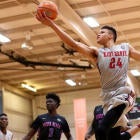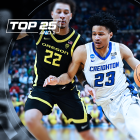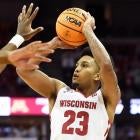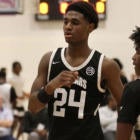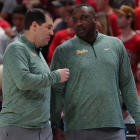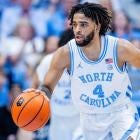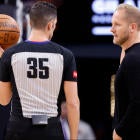I wrote a column last week from Las Vegas about what college coaches routinely call the "Packet Racket." If you missed it, you can read it here. But all you really need to know is this: it was largely about event organizers who exploit an NCAA-approved system by charging what most agree are outlandish prices for "packets" that college coaches are often required to buy before being allowed to enter a gym to evaluate high school prospects during the month of July.
Simply put, the response to the column was overwhelming.
I heard from coaches from every level of the sport -- both men's and women's coaches. And they had stories. Boy, did they have stories. So I decided to dive deeper into the subject and further explain exactly how some event organizers have turned amateur basketball into a massive business.
"Jeff Schneider has it down," said one college coach.
Let's start there, then.
Schneider is the CEO/President of Big Shots -- which describes itself as an organization that puts on "the nation's premier exposure events." Some of those events happened in Myrtle Beach, S.C., earlier this month. One was called the Big Shots All-American Camp 1. It was held on the night of July 6. Division I coaches were required to buy a $295 packet to enter. Then something called the Big Shots Myrtle Beach 1 started the following morning, on July 7, in the same complex. Division I coaches were required to buy another $295 packet to enter that event. Then, naturally, the Big Shots Myrtle Beach 2 started two days after that, on July 9, in the same complex. And, yes, Division I coaches were required to buy yet another $295 packet to enter that event.
"So here's the deal," one college coach said. "You buy three different packets for three different events and spend roughly $900 just to get in the gym. But it's basically the same teams and kids you're seeing. The only real reason they break it up into three different events is so they can charge us for three different packets. It's insane."
I reached out to Schneider for comment.
He did not respond.
Another wild aspect of the July evaluation period is how men with influence over prospects are now running what they describe as "combines." And if you're wondering why any college coach would spend several hundred dollars on a packet to attend a poorly run combine, here's why: Because, a source said, college coaches have, in some cases, been told they'll be "blacklisted" with recruits "if they don't show up and buy a packet."
"I went to one on the night of July 6," a college coach told me. "Cost $100 to get in. Total waste of time and money. But I couldn't risk not being there. I couldn't risk getting blacklisted."
One after another, the stories from coaches and industry sources rolled in over the past few days. Here's one: "I had one organizer try to make me pay $395 to watch ONE GAME. I wanted to see some poor kid who was begging us to look at him. But I decided against it because I [didn't want to pay $395 to watch just one game]. Hated it for the kid because we never did get to see him." And here's another: "I had an assistant go to one event, and while he was calling me to ask if he should really pay $395 to go in and see one kid play, the organizer charged his credit card. Once I told my assistant, 'No, it's not worth it because we only have one scholarship to offer, and we are not going back to that event,' my assistant asked for a refund. But the organizer wouldn't refund him. He said to my assistant, 'It's not your money. Just turn it in and expense it."
More than anything, that seems to be the rationale from the perspective of the event organizers who are charging these prices -- that college coaches are operating with massive recruiting budgets funded by athletic departments that wildly spend on all sorts of things. So why not charge crazy prices -- especially when coaches are usually willing to pay them because it's all just going on an expense report anyway? In fairness, that's a perfectly sensible point of view if your goal is strictly to make as much money as possible. But the truth is that while Duke, Kentucky and similar programs can spend basically any amount in July purchasing mostly useless packets to gain entry into events -- FYI: a school spending $10,000 isn't abnormal -- it can be a crippling expense for low-major programs, not to mention Division II programs, Division III programs, NAIA programs and most women's programs. So when Big Shots, just to name one organization, claims to have "a reputation of giving players maximum exposure in providing them the opportunity to play in front of primetime national recruiting services and hundreds of college coaches," that's not exactly right. Because, by charging what they charge, they maximize profit for themselves but do not maximize exposure for players -- evidence being that there are, as previously noted, college coaches who sometimes refuse to pay what they're required to pay to attend.
The above examples are but two of many.
So the obvious questions are these:
1. Why does the NCAA allow this to go on?
2. What can be done about it?
Let's tackle the first question first because the answer to that one seems simple, and it's this: the NCAA is hesitant, I'm told, to pass legislation that would in essence limit what private businessmen can make because it would likely lead to lawsuits it might lose. That's the long and short of it. In other words, if the college coaches who think the system is ridiculous genuinely want to change it, basically, it's up to them. They'd have to take a stand and, at the highest levels of the sport, make it clear that charging $300 or $400 or even $1,000 just to enter a gym to watch high school prospects is unacceptable. They'd have to show there's no longer a market for those prices.
Unless that happens, things will continue as they are and probably get worse. Unless that happens, college coaches -- many of whom work at schools that can't afford it -- will continue to be required to buy packets that cost several hundred dollars but are often worth very little. And sometimes those packets will look like this:
A few of the rosters from book here in New Orleans. Oh, & the book isn't in alphabetical order! @GaryParrishCBS pic.twitter.com/brUq6mGpgs
-- Sarah Condra (@sarah_condra) July 23, 2016












